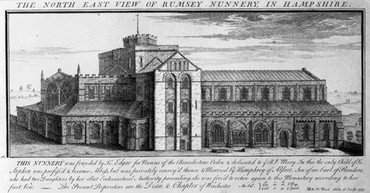A brief history
Traditionally, the Abbey Church of St Mary and St Ethelflaeda can trace its origins back to 907 AD, the year in which King Edward the Elder, son of the Saxon King Alfred the Great, first settled some nuns here under the charge of his daughter Elflaeda.
King Edgar refounded (or, quite possibly, founded) the nunnery in 967 under the rule of St. Benedict. Ethelflaeda, whose reputed acts of sanctity included chanting psalms whilst standing naked in the River Test at night, was abbess around the time of the first millennium.
The first stone church and nunnery were built c.1000 AD and flourished as a place of education for the daughters of kings and noblemen. Work began on the present building c.1120-1140 with the choir, transepts, a Lady chapel at the east end and first three bays of the nave, a fourth being added in 1150-1180. The last three arches, in the Early English style, at the west end of the nave were added in 1230-1240, at which time over 100 nuns belonged to the foundation.
In 1349, however, the Black Death decimated the population at large and, at the Abbey, the number of nuns declined to just 19. Its dark shadow had receded by the turn of the Fifteenth Century, during which a second aisle on the north side of the Abbey was built to accommodate a church, dedicated to St. Lawrence, for the townspeople.
It is probable that this shared use of the building spared Romsey Abbey from complete demolition. Many similarly fine religious buildings were lost under the general dissolution of the monasteries instigated by Henry VIII after his final break with Rome in the late 1530’s.
The Abbey was suppressed in 1539 and its nuns dispersed. However, in 1544, the townspeople were allowed to buy the building for £100 to be used as their parish church. Later, they demolished the Lady chapel and the extra aisle previously built for them because the Abbey was too large for their needs and resources.
Further damage to the fabric occurred during the English Civil War when, in 1643, Parliamentary troops entered the Abbey, pulling up the seats and destroying the organ.
A Puritan form of worship was imposed under the régime led by Cromwell and many independent ministers, including the ‘intruder’ John Warren at Romsey, were appointed.
The Eighteenth Century witnessed a long period of neglect. A visitor complained in 1742, for instance, that at least 40 windows were bricked up.
In the Nineteenth, however a renaissance of the Abbey began, particularly under the ministry of the Rev. Edward Lyon Berthon.

‘Rumsey Nunnery’, as depicted in an old lithograph
The Abbey remains the largest parish church in Hampshire and is home to a vibrant congregation drawn from the town and beyond. It is affiliated to the Greater Churches group, which includes Beverley Minster, Christchurch Priory, Leeds Parish Church and Sherborne Abbey.
Liz Hallett, the former editor of our parish magazine, published a book, Romsey Abbey – the First 1100 Years, in 2015. It contains a wealth of illustrations and is available from the Abbey’s gift stall priced £15.
Romsey Abbey boasts a fine collection of corbels (sometimes mistakenly referred to as gargoyles); take a look at the website, illustrated with lots of photos, that retired designer Roy Romsey has created about them.

